#desert punk
Text
The Punk-Factor of Punkpunk Genre
So, when I posted my history of Solarpunk, someone (probably not in good faith) asked: “So, what about the punk in all the other punk genres?!” towards my request to put the punk back into Solarpunk. And given that my autistic brain obviously cannot just let that stand… You know what? Let me talk about the other punk genre and in how far they are “punk”. I tried to be as exhaustive as possible, though there is a good chance, that I might have missed some of the punkpunk genre. So feel free to add.
Trying to judge the punkiness I do not assume punk as simple counter culture, but a specific ideology. Quote from Wikipedia:
[Punk ideology] is primarily concerned with concepts such as mutual aid, against selling out, hierarchy, white supremacy, authoritarianism, anti-consumerism, anti-corporatism, anti-war, imperialism, conservatism, anti-globalization, gentrification, anti-racism, anti-sexism, class and classism, gender equality, racial equality, eugenics, animal rights, free-thought and non-conformity
Most of the artwork here has been taken from concept art of either of the examples listed.
Sorted from most futuristic to pre(historic). Yes, the list is long.

Cyberpunk
We start with the OG punk genre, the one after which all other punk genre were named. Yes, you could argue that in fact the two genre following are more futuristic – but Cyberpunk kinda just had to start the list.
As a genre: Given that Cyberpunk had its start completely in literature it is the best defined in this regard. Taking place in a late stage capitalist dystopian world in which most is owned by megacorps who don’t follow anyone’s laws but their own, the protagonists usually are social outcasts fighting against their own oppression, trying to keep themselves alive in a world hostile to them. With cybernetics always being a core of the genre, it also tends to deal with the question of humanity in a “ship of Theseus” sort of way. How much can the human body be altered, before the human vanishes?
As an aesthetic: Cyberpunk is the most punk in terms of aesthetics, really. There is a lot of punk and grunge going on in terms of character design. Neon hair colors, fishnets and thorn up jeans jackets can be found here. As well as of course cybernetics on the characters. The world usually is a megacity with a stark divide between rich and poor, tons of neon signs, a slight Japanese influence, flying cars and somehow a constant downpour of rain.
Punk-Factor: Cyberpunk is the one punk genre, where the “punk” was chosen very knowingly as a name. Usually the protagonists are “punks” fighting for their place in the world against a suppressive capitalist system. (Also, they usually fit the punk aesthetic, if they don’t wear leather dusters.) It should be noted however, that especially in newer western Cyberpunk often the punkiness vanishes more and more – for the same reason we have so little Solarpunk: media that outright confronts the problems of capitalism is just less supported.
Examples: Neuromancer (1984), Mirrorshades: The Cyberpunk Anthology (1986), Snow Crash (1992), The Matrix (1999), Dredd (2012)

Biopunk
As a genre: As a genre biopunk is still fairly ill defined, as it mostly shows up as a subsection of Cyberpunk. Rather than the characters having cybernetic implants (or additionally to it) they are augmented on a genetic level. This can be all sorts of augmentations, changing anything from appearance to giving characters higher strength and agility, giving them claws or night vision, or in some cases even “magic” powers. Usually the genre tends to be set in worlds similar to Cyberpunk. In fact it might well be set in a cyberpunk world, only that characters with bioaugmentations exist parallel to those with cybernetics. Additionally, though, there is a subsection of this genre, that concerns reproductive rights.
As an aesthetic: Ironically biopunk is even less defined as an aesthetic. There is not a lot of biopunk art out there and most that exists can go in different directions. As such it often mixes elements from other punk aesthetics – like Cyberpunk, Steampunk or Dieselpunk – with an assortment of bodyhorror elements.
Punk-Factor: It is hard to define the “punkiness” of a genre, that barely exists for the most part. Usually, when it is set against a Cyberpunk backdrop, it might be very punky, but in other settings those punk elements vanish.
Examples: Ribofunk (1995), Altered Carbon (2002), Bioshock (2007), The Windup Girl (2009)

Nanopunk
As a genre: Like Biopunk Nanopunk mostly exists as a subsubgenre to Cyberpunk, often being set in a mostly Cyberpunk world, only that instead of or additionally to Cybernetics, the technology used to alter the human body is nanites. These serve the same function as the genetic manipulation in Biopunk, giving the human in question more strength and agility and at times more or less magical abilities. There is one common plot that comes up again and again, with an AI or megacorp turning the nanites against the people they inhabit or trying to control them.
As an aesthetic: Aesthetically Nanopunk does not have much in terms of its own identity. Most artworks relating to Nanopunk feature a similar aesthetic to Cyberpunk, with megacities and lots of neon.
Punk-Factor: This genre is so small, that it is kinda hard to judge the exact punkiness.
Examples: The Diamond Age (1995), Prey (2002)

Solarpunk
As a genre: Being another genre, that started as such, Solarpunk is a bit better defined. Solarpunk usually takes place in a world post-strive. It is post-capitalist and decolonial in its settings, usually featuring a world that has either formed against the backdrop of preventing climate collapse or in the aftermath of it. A lot of it features people rebuilding – or alternatively building communities. It always features elements about living in harmony with nature or trying to do so. So far, the genre is mostly defined by short stories, partly because there is still disagreements within the movement, how far a conflict can be taken to still qualify as Solarpunk.
As an aesthetic: Solarpunk has a very strong aesthetic definition, mostly featuring all sorts of cities and urban areas, that incorporate natural elements into the urbanity, with greenery growing on roofs and concrete car-centric streets being replaced with more natural, walkable areas. The character design aesthetic is not quite as clearly defined, but usually features natural materials and patterns usually seen within indigenous art.
Punk-Factor: Contrary to what many say, Solarpunk is fairly punk, as it very much embraces the entire anti-hierarchical, anti-capitalist mentality. With the big difference, that the punk mentality is no longer counter culture, but the mainstream culture.
Examples: The Dispossessed (1974), Nausicaä (1984), Laputa – Castle in the Sky (1986), Princess Mononoke (1997), The Summer Prince (2013)

Lunarpunk
As a genre: Lunarpunk is pretty much a subsubgenre of Solarpunk, just as Nanopunk and Biopunk are sprung off from Cyberpunk. It is so far ill-defined as a genre, but the general consensus is, that it is set in solarpunk-esque worlds, but with a heavier focus on mysticism or spiritualism, at times outright including magic. It also tends to feature a lot darker places, being set in underwater or underground settings – or alternatively at night.
As an aesthetic: Lunarpunk is far more of an aesthetic than a genre so far. It features dark places, often with bioluminescent elements in it. Often featuring a mixture of black and dark blue with lighter blue, violet or light green elements shining in the middle of it. Mushrooms – especially glowing mushrooms – feature repeatedly in artwork.
Punk-Factor: Given that Lunarpunk is barely defined as a genre it is hard to estimate the punkiness in it. If it gets more stories, will those still feature the anti-capitalist and anti-hierarchical messaging we see in Solarpunk? This should be the defining factor. Some of the artworks use little aesthetics from the punk scene, but nothing much more.
Examples: Bioluminescent: A Lunarpunk Anthology (2023)

Hopepunk
Honestly, I had no idea where to put this one, given that it might technically be set at any time and place.
As a genre: Hopepunk is very much a genre, not an aesthetic. It has been defined as the opposite of grimdark by its “inventor/name-giver” Alexandra Rowland. The basic idea is to create fiction that instead of taking a dystopian, defeatist and violent approach, takes one defined by hope and to some degree pacifism. As such the genre can be set in any setting, real or fantastic. It mostly is defined by the protagonists taking opposition to cruelty and violence, fighting for a better world and, crucially, also partly archiving it. Other than in usual Cyberpunk, where the best possible ending, tends to be, that the protagonists get to live a somewhat better life themselves, Hopepunk aims to better the life at least for groups of people.
As an aesthetic: Being fully a genre, Hopepunk has no aesthetic associated with it.
Punk-Factor: Hopepunk is punk less in the sense of the protagonists or things happening within the story, which might or might not be punk, but was named such rather because it is considered counter cultural towards the gross of media at the moment, that often strives for a “realistic, gritty, grimdark” outlook on the world. Basically it is saying: “Hope is punk.” I will not make any judgement on whether or not this is true.
Examples: The Long Way to a Small, Angry Planet (2014), Mad Max: Fury Road (2015), The Good Place (2016)

Mythpunk
As a genre: Another one, that does not really fit into a temporal sorting system, because once again it can be set anywhere between the stone age and the far future. The basic idea is, that the story interweaves postmodern storytelling with elements from mythology or folklore. This can mean mythological, genre-traversing retellings, but it can also mean, that mythology seeps into any given story bit by bit. As such the genre with probably the most media in the subgenre is Urban Fantasy, which often borrows from mythology and incorporates these elements.
As an aesthetic: Mythpunk as an aesthetic is a bit strange. There is definitely a mythpunk aesthetic that exists, often mixing familiar elements with elements from mythology and folklore (at times also including quasi-folkloric works of literature, such as Alice in Wonderland and the Wizard of Oz). Often just a bit dark and twisted.
Punk-Factor: To be perfectly frank, for the most part, there is not a lot of punk to be found in this genre. While there have been definitely punky stories told within the genre, this is more a story decision than something inherent to the genre.
Examples: Pan’s Labyrinth (2006), Over the Garden Wall (2014), Inscryption (2016)

Dustpunk / Rustpunk / Desertpunk
As a genre: Kinda grouping those above all together, because people argue about what they might entail and in some interpretations they kinda are similar: Post-apocalyptic stories set in a world of sand and rust. Often featuring a loner character, having to go up against everyone to ensure his own survival – and at times being forced to learn, that the lonerness might not win him (and most often it is a him) anything.
As an aesthetic: Aesthetically this tends to be very much post-apocalyptic, maybe in some cases with some more classical punk elements added to characters and surroundings.
Punk-Factor: Given that there is neither a system to rage against – nor a new, less hierarchical system – usually there is not that much punk outside of some aesthetic choices. Neither tend those stories go into constructing worlds of mutual aid or working against oppression.
Examples: Anything Mad Max should count for this.

Atompunk
As a genre: Atompunk usually deals with themes connected to the cold war – in some cases directly, in some indirectly. Often it overplays the American ideals that were pushed for during the cold war era and portrays scenarios in which American Exceptionalism slowly reveals itself as the dystopia most punks already know it to be. Outside of this vague idea for the setting, the genre is less described, as there is less of a clear script an Atompunk story might follow. So, little description of who might be the protagonist and what their role is.
As an aesthetic: The aesthetic of Atompunk borrows heavily from the Raygun Gothic aesthetic. So, futurism, as it was imagined in the 1950s and 1960s, with heavy influences from late pulp age science fiction art.
Punk-Factor: The aesthetic in this is definitely not punk. The stories often have some vague punk ideas of recognizing how fucked up the world has become, but given the genre is fairly wide in terms of stories, it is hard to give a definite answer to how “punk” it is. One can definitely tell punk stories within this genre, though.
Examples: Hitchhiker's Guide To The Galaxy (1978), Fallout (1997), Futurama (1999)

Dieselpunk
As a genre: Dieselpunk is once again an example of “strong aesthetic, but no clear genre identity”. Generally, Dieselpunk is concerned with the interwar period, but might cover either of the world wars. In some cases the genre features alternate timelines, in which one war happened and not the other, or in which another faction won, with the technological development being influenced by this as well. But as a genre it is not much defined. A lot of stories building on Lovecraft’s legacy feature Dieselpunk in some regards. And there is definitely a subsection of Dieselpunk stories centered around “what if Nazis won” or “what if Nazis somehow went underground and did their own technological development after the war”. Also, there are a lot of stories about pilots of war planes in this genre.
As an aesthetic: As an aesthetic Dieselpunk is more clearly defined. A lot of bare metal and the sorts of technology you would expect from this era, often with retro-futurist and art noveau elements in between. A lot of the fashion within the genre is defined by pilot and military clothing of the times, but at times also dipping into “roaring 20s” fashion styles.
Punk-Factor: In this genre I would generally say: “If the story involves punching Nazis, you might get a couple punk points – but otherwise this is not really punk.”
Examples: The Iron Dream (1972), Brazil (1985), Dark City (1998), Iron Sky (2012), Bitter Seeds (2010)

Teslapunk
As a genre: Yet another one of these, that exists mostly as a vague idea, with no clear definition. The basic idea is a world, that works on Tesla’s inventions. And as those of you, who watched Doctor Who, might know, Tesla sorta, kinda already invented the internet or had an idea of what it could be and how it could work. So a Teslapunk world is based in an alternate timeline, but might in fact go into light futurism. There is not much in this genre though with a unique thematic identity, as stories that use Teslapunk as a backdrop rarely have coherent themes.
As an aesthetic: The aesthetic of Teslapunk is basically “Steampunk, but with Tesla-coils and electricity”. Which is not a big surprise given that Tesla came from the same era that would also be the inspiration for Steampunk. So, we have a lot of Victorian fashion, maybe some light augmentation, airships, and – again – all the tesla coils you can muster.
Punk-Factor: As, again, I think punk is more about themes than aesthetic, this is once more not really possible to judge, because there do not seem coherent themes within the genre so far.
Examples: The Prestige (2006), Sherlock Holmes: A Game of Shadows (2011), Bioshock Infinite (2013)

Arcanepunk
Another one of those that do not neatly fit into the timeline…
As a genre: Arcanepunk takes place in a world, where both magic and technology have developed. In some cases both developed side by side, in others, we might have a technological world, that suddenly discovers magic by some happenstance. The fact is, though, that both exist parallel to each other or might at times be intertwined, with technology being powered by magic. This can exist at different technological stages, usually featuring settings inspired by the late 19th or early 20th century. But usually futuristic stuff that includes magic might be considered Arcanepunk, just as might stories that mix 18th century technology with magic. While also a vague genre, there is a repeating theme of magic being hoarded by those in powers and the poor and downtrodden finding ways to still use it in their own advantage.
As an aesthetic: Given that Arcanepunk’s setting is defined by the co-existence of magic and technology, rather than a specific technology, Arcanepunk has less of a defined aesthetic. Never the less, we have a part of punk aesthetics that often come up, as a surprising amount of Arcanepunk features characters with neon colored hair.
Punk-Factor: Another genre that is rather thin, yet, there is a surprising amount of stories featuring some punk ideas of fighting against an oppressive system and being counter culture to a main culture build around suppression.
Examples: Too Many Magicians (1966), Shadowrun (1989), Bartimaeus (2003), Arcane (2021) duh

Steampunk
Steampunk was the second genre to pick up the “punk” suffix and hence is as much responsible for the punk-punk as Cyberpunk as the originator.
As a genre: Being named as early as it has been, Steampunk kinda suffers the same issue as Cyberpunk itself. There is a lot of ideas there, but some are only vaguely defined. In general, though Steampunk always takes place in a world where the steam engine became the defining technology and was never replaced with the combustion engine. As such cultural aspects from the steam era, especially Victorian England and the Belle Epoche, still carry over for longer, than they did. So often we will see noble households based around similar values as the puritan Victorian English families, while the very poor are made to work in workhouses. At times we might also see themes of colonialism here. In some cases magic might exist in these worlds, as might electricity for some aspects. There is often a heavy inspiration from Jules Verne and H.G. Wells. Though it is still hard to define the “stereotypical steampunk story”, given that Steampunk offers a wide variety of stories, from adventure stories and romances, over to stories where people rise up against the Victorian-esque society.
As an aesthetic: Steampunk as an aesthetic is very much influenced by Victorian aesthetics and the time period of the late 19th century, mostly in the USA, Great Britain and France. But as all other punk genres it knows very well: “If it is worth doing, it is worth overdoing,” so steam-related elements are added to everything. Could
Punk-Factor: In the original idea for Steampunk was a lot of punk. “What if we took Cyberpunks ‘rage against the unjust system’ and made it 19th century” they asked. But given that the genre branched out so much, it is not necessarily there in all the stories. There is a ton of stories where people rage against that steam powered Victorian machine – but also a ton in which the Victorian world gets idealized and romanticized.
Examples: Thief (1998), The League of Extraordinary Gentlemen (1999), Wild Wild West (1999), Clockwork Century (2008) – also half of all Sherlock Holmes adaption made after 2000 in any medium usually use Steampunk elements

Silkpunk
As a genre: Silkpunk is hard to define, despite there being a clear definition. The reason for this is, that the person who coined the term – Ken Liu – had a very specific idea in mind. He explains that the idea is of a world that has technology as language. In which form is as important as function, is made to speak a language all of its own. Inspired by ideas from W. Brian Arthur and Chinese philosophy. However, what the wider Science Fiction and Fantasy community made from it was “Steampunk but East Asian!” But given he coined the term (and also the alternative feels vaguely racist) I am going to go with Ken Liu for this. While Silkpunk will usually be set in an East Asian inspired world, the central idea is about the duality of technology, which will also be addressed within the stories.
As an aesthetic: As said above, the idea Liu had for it was a world that features some technology, but technology that is as much about form and communication through it, as it is about function. So the technology here has strong visual ideas. At least that was, how Liu intended it. Once again, the wider community made “Steampunk, but East Asian” out of it.
Punk-Factor: There is not a lot of stuff in this genre for now – however so far I do not manage to see a lot of punk ideas in it, even though some of Liu’s stories definitely feature the concept of challenging a higher power.
Examples: Dandelion Dynasty (2015), The Black Tides of Heaven (2018), The Tea Master and the Detective (2019)

Clockpunk
As a genre: Once again storytelling in this genre is not really defined, but the worlds diverge a bit before the wide adaption of steam, instead featuring mechanical devices powered by coils and springs and somehow kept alive, often at least implied through some form of arcane magic that gives “live” to these mechanical inventions. Most examples of Clockpunk, however, tend to show up as settings for parts of fantasy stories. Any fantasy world might have this “Clockpunk” area, where protagonists might travel. Especially games tend to feature this. While there is definitely a trope of the “mad inventor” often going along with this, few other tropes stand out.
As an aesthetic: The aesthetic of Clockpunk tends to take some inspiration from the early 19th century, but tends to add a lot of gears to everything, with even city wide gear constructions keeping things working. We often will find mechatronic characters, such as wind up soldiers or wind up dancers.
Punk-Factor: Once more, there are so few stories told, that it is kinda hard to speak about how punk this is. Most stories told so far, however, do not feature punk elements.
Examples: The Great Mouse Detective (1986), Hugo (2011), Clockwork Planet (2017)

Whalepunk
Please note: This is one of those genre, I would love to see more in, though so far it is barely explored.
As a genre: And you might ask: “Why do you even name those genre, that exist mostly in theory?”, to which I might answer: “Because I am a nerd.” As all these retrofuturists genre, Whalepunk imagines mostly an alternate historical timeline, where the technology that became defining was based around whale oil. This means that in Whalepunk often whalers or harbors play a big role, though as the genre is again very thinly spread, it is hard to say what “THE whalepunk” formular is. It seems there is a tendency, to mix some mysticism or magic into the genre, though, as the idea of hunting sea monsters often plays into it as well. Good chance that it could at some point merge with Cthulupunk (which I did not name separately, because most of it is either covered in Whalepunk or Dieselpunk).
As an aesthetic: The aesthetic of Whalepunk is basically “Steampunk, but with more sailors, ships and sea monsters”. There is definitely a bit of Oceanpunk mixed into it as well, with some aesthetics being somewhere between Steampunk and Dieselpunk. (Which is kinda ironic, because whale oil was mostly used in the early 19th century.)
Punk-Factor: And again. There so far is not a lot of connective thematic tissue within that genre, so exploring themes is kinda hard.
Examples: Dishonored (2012), Dredge (2023)

Oceanpunk / Piratepunk
As a genre: It really is hard to divide the Piratepunk out of the Oceanpunk, though some might call it different. The idea here is that this genre features stories mostly set on the ocean and often more heavily leaning into fantasy, than science fiction. While the worlds might feature technological elements, they will almost certainly feature magical elements of some sort. The characters will usually be seafaring one way or another and stories might involve any sort of adventure. There might be a storyline, though, about one company or nation trying to control the seas – often times through magical means – with the characters often unwillingly being made to oppose them. This genre might also take place in a post-apocalyptic setting with a flooded planet.
As an aesthetic: While the aesthetic is not clearly defined, there is a good chance that it borrows heavily from the late 17th and early 18th century and the golden age of piracy, when it comes to both ships and fashion sensibilities.
Punk-Factor: Pirates, at least as far as modern media imagines them, tend to be very punk, as they tend to inherently oppose any sort of government and what not. While the punk is not there in all of the stories, a lot of the most popular stories from the genre will feature at least lightly punky elements.
Examples: One Piece (1997), Pirates of the Caribbean (2003), Assassin's Creed IV: Black Flag (2013)

Dungeonpunk
As a genre: So, the idea of the genre is basically “What if Cyberpunk, but Dungeons & Dragons?” Usually set in a vaguely medieval world, this world still shows the same corporate corruption as your usual Cyberpunk world. Adventurers are just another resource to be exploited by the system, their day job involving going on yet another dungeon crawl. For this there might be some technology entirely powered by magic, with those magic items taking over the same functions technology might have in a Cyberpunk world. And yes, indeed some brave dwarf, elf or halfling might rise up and challenge the corporate dungeon syndicate. (As you might sense: Yes, this genre tends to be at least partly a bit of a parody of the punkpunk idea. Though it also can be played straight as “Cyberpunk conflicts, just that all technology is somehow magic.”)
As an aesthetic: This is once again one of the examples, where there is a clear idea behind it – but absolutely no clear aesthetic, as this genre might cover anything from medieval settings to a lot more modern stuff.
Punk-Factor: The base idea, being heavily inspired by the base idea of Cyberpunk, just from a very different perspective. But too many people read the genre as “Magic Technology, yay”, in which case, no, it is not punk.
Examples: Dungeons & Dragons can be played this way, also Final Fantasy VI – XIII definitely counts.

Sandalpunk
As a genre: I mostly include this for the sake of it, because this genre tends to boil down to “fantasy set in ancient Greece or Rome, but with vaguely anachronistic elements”. It might also include alternate history stories (even going so far as Science Fiction) based on the idea “What if Ancient Rome/Ancient Greece never fell?” There is no real overarching themes, even though I could imagine some interesting way one could build those up. So far, though, it is mostly a vague gesture towards: “SciFi Fantasy, but with more ancient civilizations.”
As an aesthetic: The aesthetic is usually just Ancient Rome or Ancient Greece, but with more magic or anachronistic elements.
Punk-Factor: Given the super vague nature of the genre and the fact that it seems more like a genre of hindsight (with most media being declared this having been released even before 2000)… Nobody wrote those stories to be punk. The one punk thing I can see about several of these stories is people challenging Gods, but… That’s about it.Examples: Hercules: Legendary Journeys (1995), Xena: Warrior Princess (1995), God of War (2005)

Stonepunk
As a genre: The basic idea of Stonepunk is, that it is set in a stone age world, but with the technology being pressed towards a very anachronistic end, which is often played for laughs. Basically it gives stone age people a modern seeming world, though not really. Often enough this is used to make a point about the modern world and parody it in some regard. An argument can be made for stories, that feature stone age technology people being somehow subjected to modern technology (for example through time travel or space travel) also possibly falling into this genre.
As an aesthetic: Usually the aesthetic of Stonepunk is one of an overplayed stone age setting. The clothing characters might wear are not what we know is historically more accurate but really just “everyone wears a pelt around their shoulders”. Meanwhile stone age tools get spun to be used as all sorts of modern technologies.
Punk-Factor: The genre does usually not feature punk themes. However, the nature of parodying and challenging the modern world tends to be punk in its own merit, I assume?
Examples: The Flintstones (1960), The Croods (2013), Horizon: Zero Dawn (2017)
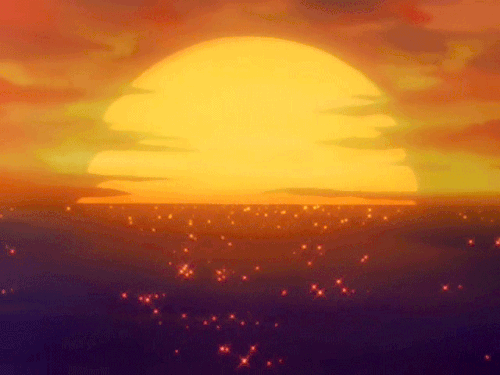
That's it. That's the list.
Feel free to add to it.
#long ass post#punkpunk#punk genre#definition#cyberpunk#steampunk#biopunk#nanopunk#solarpunk#lunarpunk#hopepunk#mythpunk#dustpunk#desert punk#atompunk#dieselpunk#teslapunk#arcanepunk#silkpunk#clockpunk#whalepunk#oceanpunk#dungeonpunk#sandalpunk#stonepunk
964 notes
·
View notes
Text
I came across that... cyberpunk bikini thing on Pinterest and thought of Marik wearing it!~💕
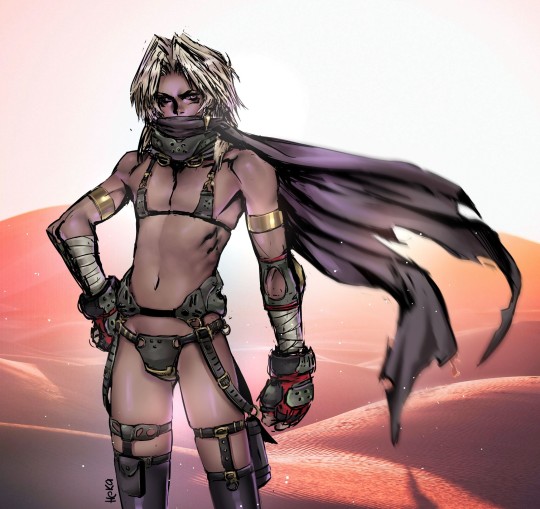

59 notes
·
View notes
Text

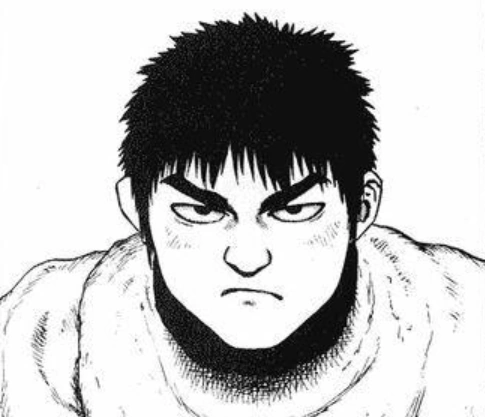
I just realized just how similar these two are in many ways, and how entirely different they are in others. They would fucking hate each other.
Is "Short snarky professional dude" a character archetype? It's a favorite of mine clearly.
20 notes
·
View notes
Text
WHERE are the other punks with very soft and round features‼️‼️💥💥💥
#the ghost show(me)#punk#punk rock#folk punk#desert punk#pirate punk#steampunk#cyperpunk#gothic punk#theres so many fucking types of punk i love us#trans#fat positivity#fat liberation#i am a fat punk!!!!#i am a trans man.#DO NOT misgender or call me feminine in anyway.
61 notes
·
View notes
Text
Do You Know This Anime?

19 notes
·
View notes
Text
Stephen King's The Dark Tower did the multiverse trope before it was cool
I was 16-17 when the live-action adaptation was announced and decided to read the Dark Tower series since I wasn't about to watch the movie. A week and a half later, I've ran through the main series like a drug addict through a mile-long line of coke and I'm reading the prequels and standalone material like "Wind Through the Keyhole" to get more content. Lemme explain:
The World of Roland Deschain is part-western, part-metafiction, part-scifi, part-post apocalypse, and part-fantasy. To mix all these genres together, Stephen King simply layered them on top of each other. To summarize: thousands of years before the start of our main story, a highly advanced human civilization waged war on every level (nuclear, chemical, biological, etc) and wiped themselves out, leaving robots, AI, mutated creatures, and broken-down tech behind them. Later, a collection of kingdoms known as "Baronies" arise and here is when Roland Deschain, our hero, is born. The kingdoms combine elements of medieval fantasy and the Western genres. There's wizards and magic, but also horses and guns. Instead of sword and sorcery, it's gun and sorcery, with Roland's gun being forged from King Arthur's own sword so gunslingers are basically medieval knights with codes of honor and customs.
Before book 1 begins, Roland's world as he knew it is ended and he must find the Dark Tower to prevent all of the multiverse from collapsing. Turns out that before the super-advanced society collapsed into global war, they figured out how to make portals to other universes and that the Dark Tower is the hub of all known reality. The Tower stands on six "beams" of metaphysical material but the people of the old world replaced them with their own material in a bid to warp reality for their own gain. Before they could, their world fell and the Beams have spent millennia slowly rotting since they're now made from real material. Due to this rot, the reality Roland inhabits has basically been on its deathbed for a long time. Time and the cardinal directions are eldritch and wonky, the poisons and radiation released during the war of the ancients still taint the soil and mutate the animals into monstrosities, and deserts dominate the landscape. What robots that survived their creators' destruction are all sociopathic and insane from the isolation. There are tears in reality that let in creatures or can take you to other realities and what humans remain are scavengers and eke out poor livings. The series has something for everyone so even if you aren't invested in the plot, you'd still be impressed at how cowboys, robots, mutants, magic, and demons can exist in technically the same universe.
#the dark tower#horror#roland deschain#scifi#western#desert punk#dystopia#post-apocalypse#post apocalypse#post apocalyptic#the man in black#randall flagg#walter o dim#jake chambers#susannah dean#eddie dean#high fantasy#multiverse that doesn't get annoying#multiverse#eldritch#the gunslinger#wizard and glass#wolves of the calla#the waste land#the wind through the keyhole#susan delgado#roland of gilead
11 notes
·
View notes
Text

Desert Punk ~ Sunabouzo
#manga#manga art#anime and manga#black and white#anime#manga panel#manga and stuff#manga stuff#manga screencap#manga edit#desert punk#desert#sunabouzo
66 notes
·
View notes
Text
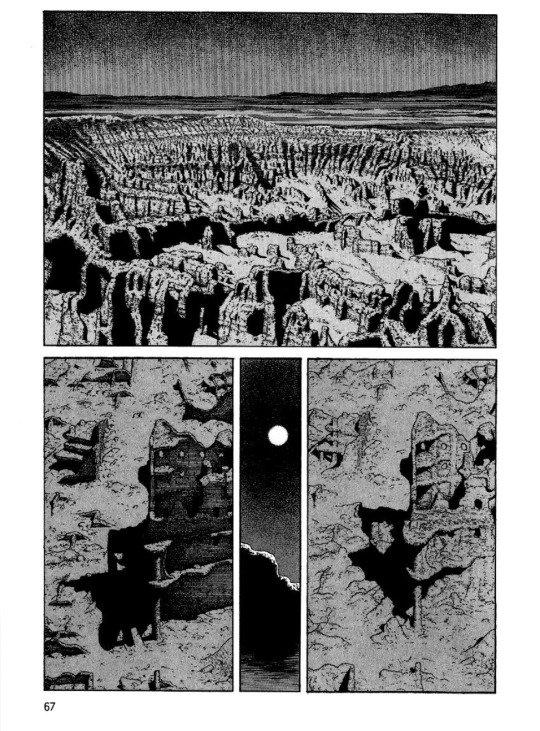


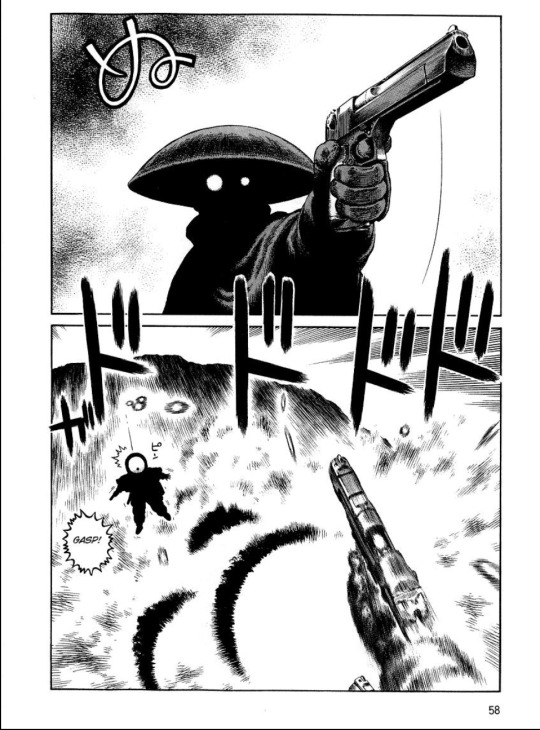
Desert Punk Ch. 72
#i just love how crumbly and soft and dry everything is while the characters look suitably warped by and suited to it#manga#desert punk#these shots are out of order save for the second and third#just wanted to showcase the chapter
23 notes
·
View notes
Text


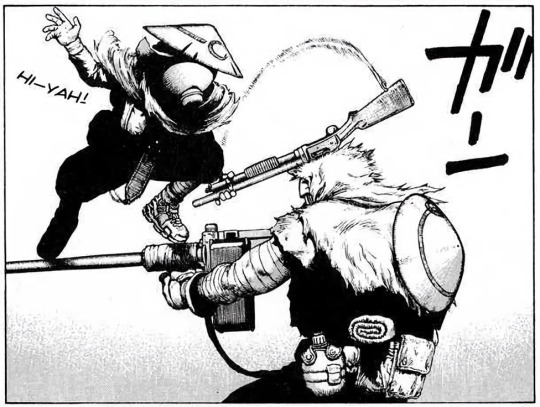
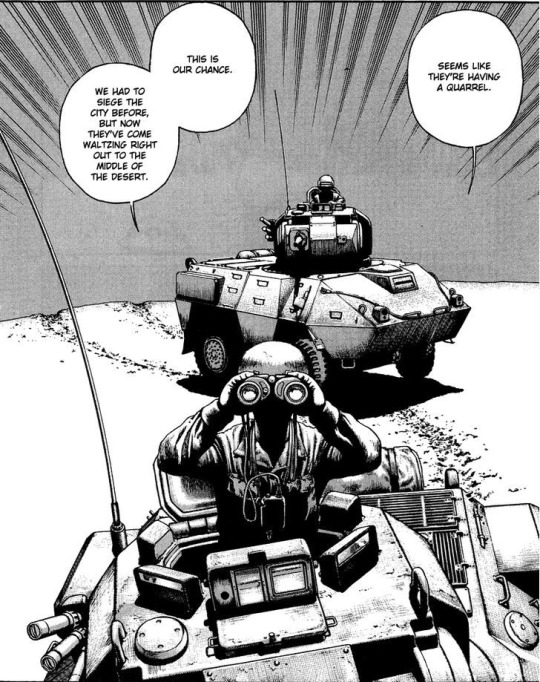





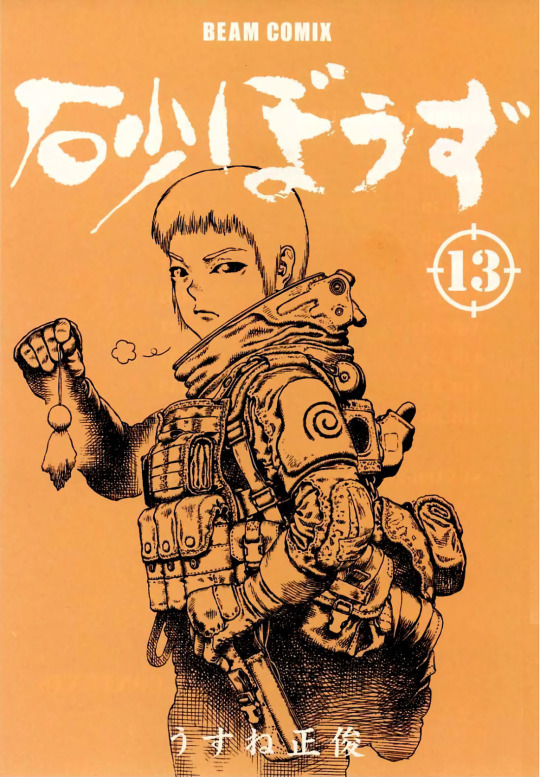
DESERT PUNK
#desert punk#manga#post apocalypse#apocalyptic#desert#wasteland#guns#firearms#tactical#aesthetic#survival
14 notes
·
View notes
Text
Mad Max and Desertpunk
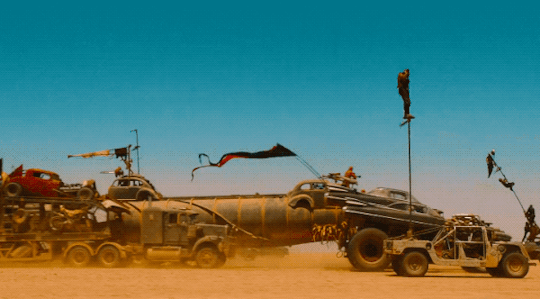
It's punk-o-clock and someone really should finally agree on how we are gonna call those kinda stories and how we are gonna define them. I have read so far:
Dustpunk
Rustpunk
Desertpunk
The Apunkalypse
And some people say those are different things, but reading over the different descriptions I gotta say: "They sound pretty much the same to me."
There might be an argument made that "The Apunkalypse" is a subgenre and then Desertpunk/Rustpunk/Dustpunk is one subgenre - and Oceanpunk can be another one... But the three formerly named once pretty much sound the same to me. Big drought. Desertification of large chunks of area. And often enough they do involve cars in a major roles as the best way to cross the desert.
And I talked about it before: But I freaking LOVE Mad Max, especially Mad Max Fury Road. God, I love this movie so much. Just... Yeah... Love. Pure love. Best movie.
And I would argue that no matter what we call that genre (I would argue that Desertpunk is the best name) that especially Mad Max Fury Road and Tank Girl are the prime examples of it. Why? Well, you know it. Because they are the most... punk.
Mad Max as a series definitely starts not out as very punk, given that Max is in the beginning literally a cop. Road Warrior and Thunderdome definitely have some punk themes and aesthetics in there, but they do not go there the full way. Meanwhile Fury Road is all like: "Smash that toxic patriarchy and metaphor for capitalism!" And I am all there for it.
Tank Girl of course is even less subtle. Both the comics and the movie are just openly punk. Tank Girl herself is a punk, wearing punk attire and literally fighting capitalism, while also being very openly bisexual. I love it.
And I think that is what should differentiate Desertpunk from just your average Post-Apocalyptic storystelling. If you have a post-apocalypse in which just everyone is out for themselves with maybe small survivor groups battling each other... I mean, you could still tell a punk story in there by focusing on the community and mutual aid aspect of punk, but in general most stories in those settings are not, in fact, punk.
But if you put in some sort of institution with people who try to exploit the post-apocalypse for their advantage? Yeah, fuck. That's so darn punk.
Ironically, Desertpunk is probably the Punkpunk genre, for which I can think of the clearest examples of PUNK in there. Kinda funny how it goes. But given that I love both Fury Road and Tank Girl so fucking much as movies... I definitely want to see more of this!

#desert punk#post apocalypse#dust punk#rustpunk#tank girl#mad max#mad max fury road#punkpunk#punk-o-clock#scifi#science fiction
64 notes
·
View notes
Text

#Desert Punk#Masatoshi Usune#manga#mangacap#art#Manga terrain#manga landscape#cyborgs#Scantaltor quality
6 notes
·
View notes
Text
You know what, sure. Fav anime openings in no particular order (although Ai Wo Torimodose is number 1 obviously).
youtube
youtube
youtube
youtube
youtube
youtube
youtube
youtube
youtube
youtube
#hokuto no ken#fist of the north star#kaiji#dorohedoro#one punch man#bastard!!#bastard heavy metal dark fantasy#air master#airmaster#jjba#jojo's bizarre adventure#cutie honey#desert punk#I hate re: cutie honey but it does have the best actual op overall
4 notes
·
View notes
Text
Kanta Mizuno
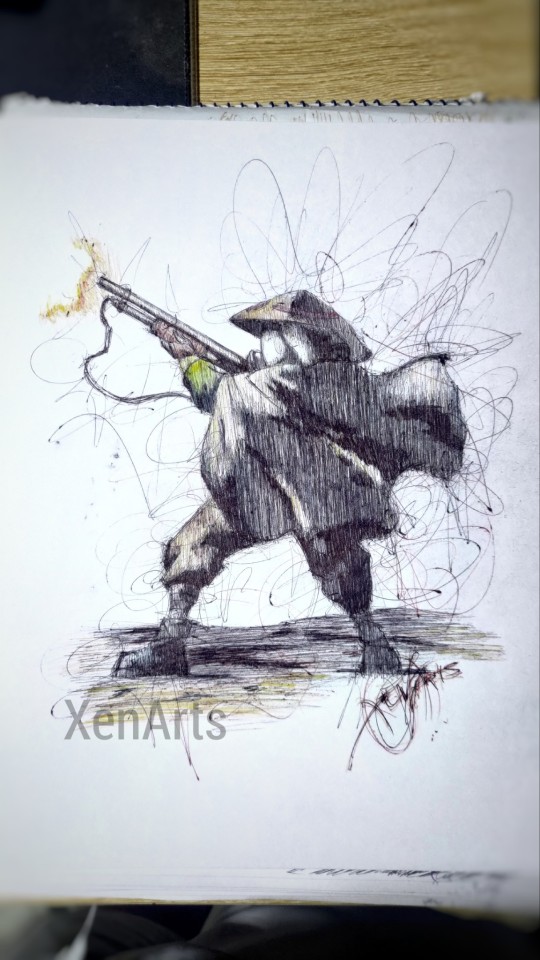
7 notes
·
View notes
Photo

[OC] Shes fire, shes death, shes comin for your head.
Had a lot of fun dishing out a design for this girl. One of my oldest OCs, since highschool over 10 years ago !! I’m feeling invigorated by reinventing her story.
#original character#dragon girl#girl with horns#desert punk#desert fantasy#my character#procreate#support real artists
5 notes
·
View notes
Text

“Sunny is a made-up name. Easy to pronounce. A runny egg with a cheerful yolk.”
-
A quick character concept for my new project, Tiger & The Viper.
#Sunny Joon#talking about the stupid performer name her record label gives her#TigerandTheViper#cyberpunk#desert punk#oc character#book characters
3 notes
·
View notes
Note
❤️ Happy WorldBuilding Wednesday! ❤️
What are your cities or towns like? Feel free to talk about the layouts or the people or the architecture, etc. and to talk about more than one if you'd like!
This is particularly juicy subject matter for me and I love talking about it.
The Citadels: These are walled temple compounds where important spiritual leaders live and work. The walls are rough and jagged. They're made of rocks, scrap metal, and broken glass - designed to keep out anyone who would hurt the people inside. But once you get through the gates, the Citadels are beautiful. Structures inside resemble cobb houses or "earthships," since sand and stone are the main resources available for construction. But human garbage and detritus left over from the old world is everywhere, and can be quite useful, so some homes have "stained glass windows" made of colorful bottles, or frames made from old pipes. It's a strange juxtaposition of re-emerging primitive building techniques, and leftover glimpses of what life was like before the drought. Temples and homes alike are highly decorated. Water imagery is common in murals, wall carvings, and stone-and-glass mosaics. Windchimes fill the air with music. Fluid, organic shapes are preferred over square rooms and hard lines. At the center of every citadel is a fountain or well. The Angels of Yema live inside the Citadels, as do their protectors and companions, the Waterdogs.
The Townships: Outside the walls of the Citadel are settlements of people who are devoted to the temples and the Angels. Because the Angels' work gives them much more access to water than people living in other areas, they're able to grow food and medicine. Simple cobb homes are the norm here, usually a little less ornate than the ones around the temple. However, the structures outside the walls usually incorporate more of the old world trash, like plastic and corrugated metal. The people here are able to enter the walls more or less freely, for worship and festivals, or to visit friends and family who work and live inside. The families of Waterdogs usually live in the townships. Life here is simple, slow, and (knock on wood) quite peaceful. Stray dogs are fed and treated with kindness, since dogs are associated with the Goddex Yema.
The Wasteland: Beyond the protection of the Citadels stretches miles and miles of desert, and the remains of old world towns half buried in sand. Out here, no one stays in one place for very long. People travel alone or in small groups. Among the wanderers in the desert are dowsers and water witches - people who do not have the gift of Yema's Angels, but who use other water-related folk magic. Some of them have real skills, and some are charlatans. Other wanderers include traders, sex workers, and bands of storytellers and musicians.
(One notable group that travels in the wastes are the Last Days Dancers: a small and mostly harmless cult of hedonists who believe that there's no point in trying to build the world anew, and spend their days drinking, doing drugs, having sex, and dancing themselves into euphoric delirium until they die of dehydration.)
The Outposts: Scattered here and there across the wastelands are places where travelers can stop to trade, rest, and hear the latest gossip. The atmosphere in these places varies depending on who runs them. Two notable examples...
The Bowl: A large dry lake bed that serves mainly as a trading outpost and a safe place for sex workers to operate. It's a No Weapons Zone, and anyone inciting violence is promptly escorted out. Buildings here are mostly crude lean-tos, though some of the larger structures are built from the skeletons of boats.
Jimmy's: A smaller outpost surrounding what was once a bar - the only original building left standing in the remains of a small town. It's known for gambling and prizefights.
2 notes
·
View notes